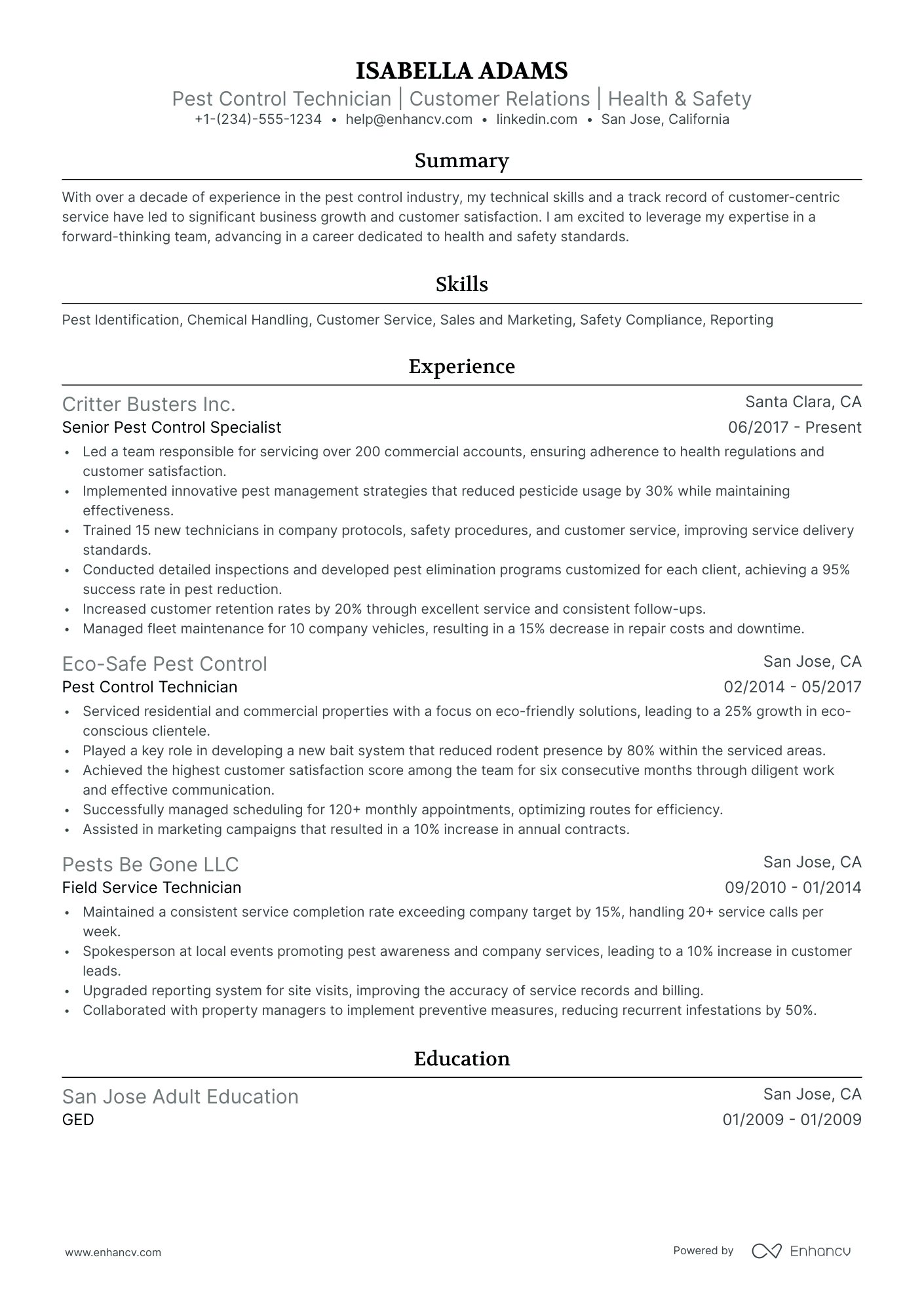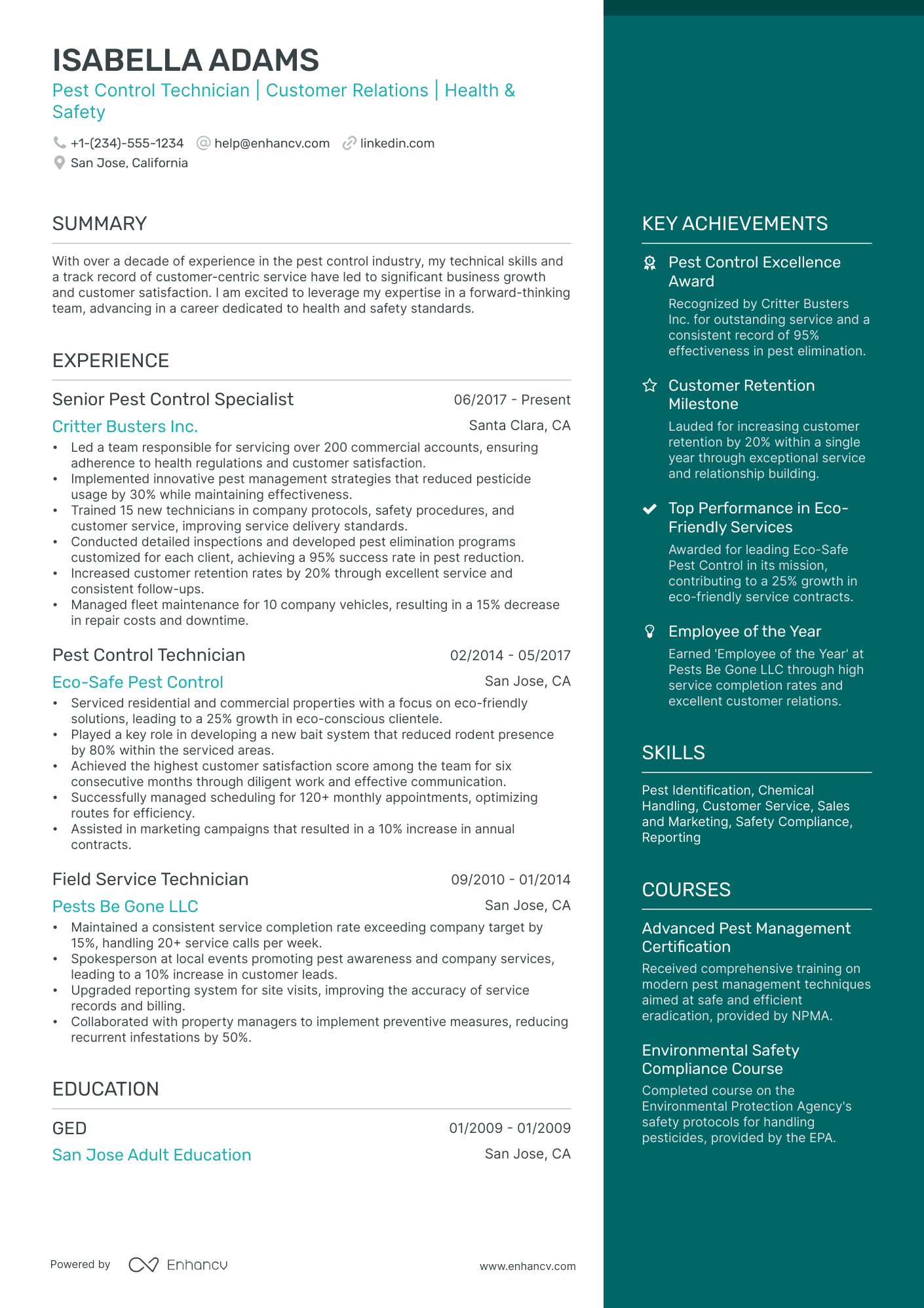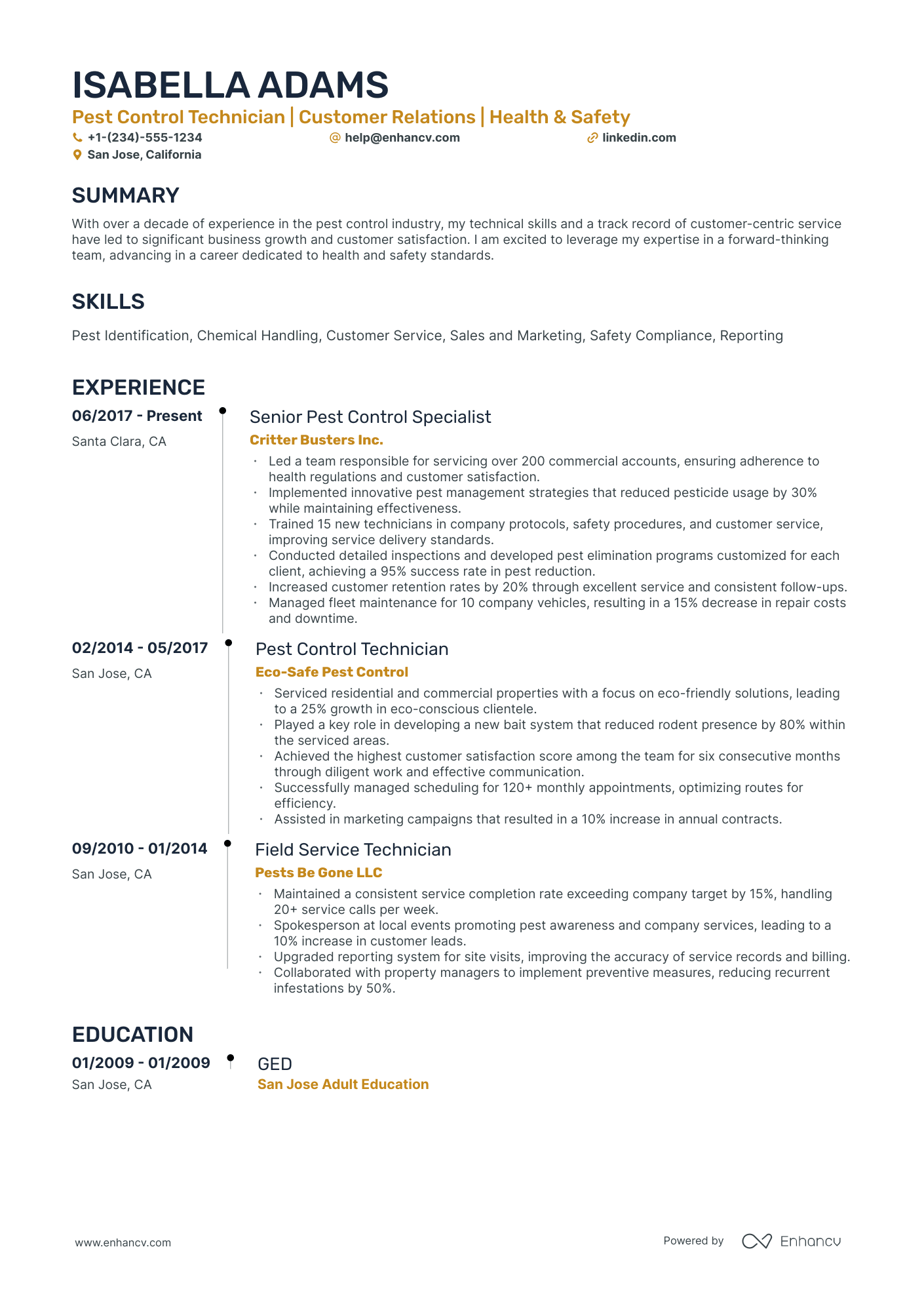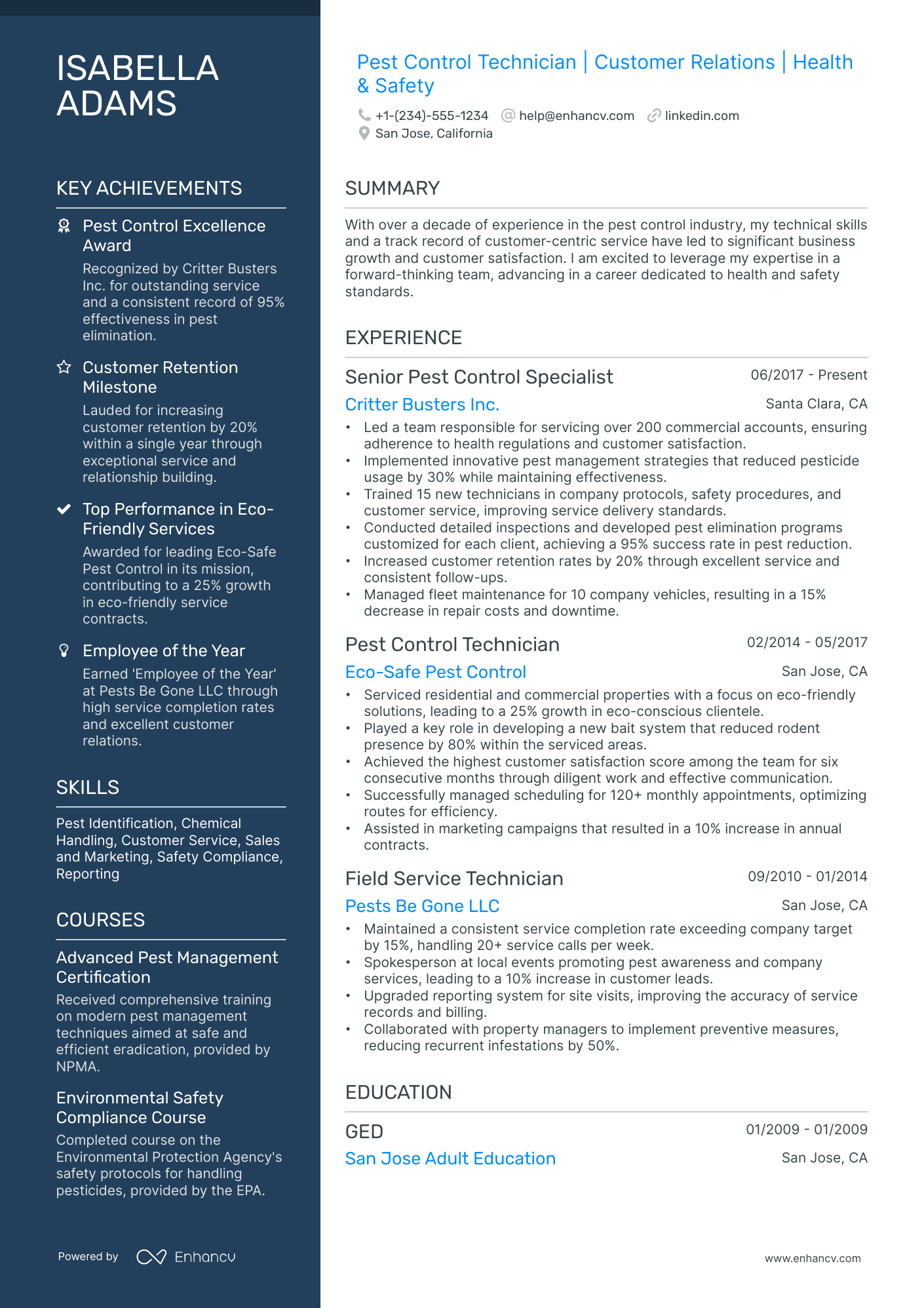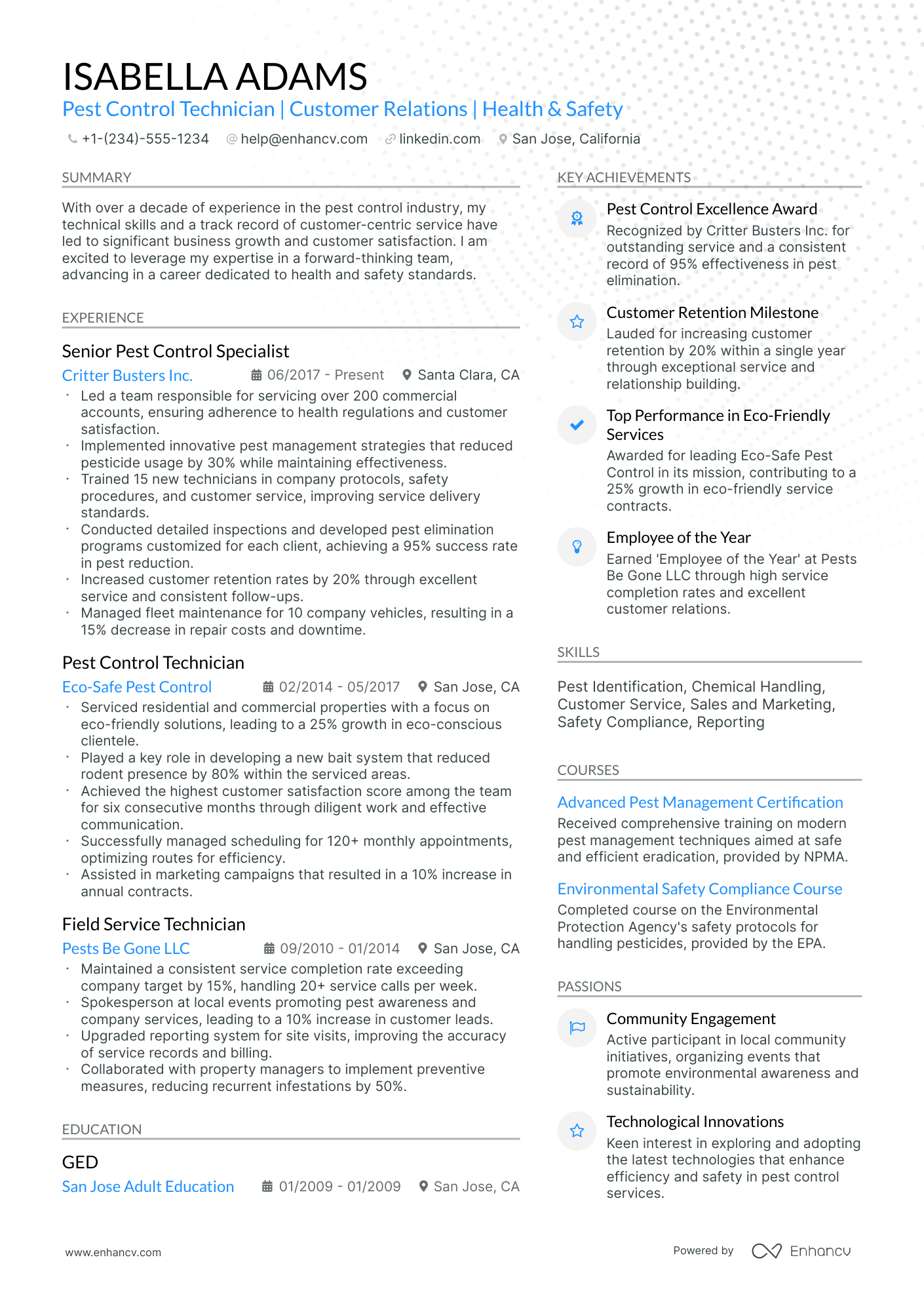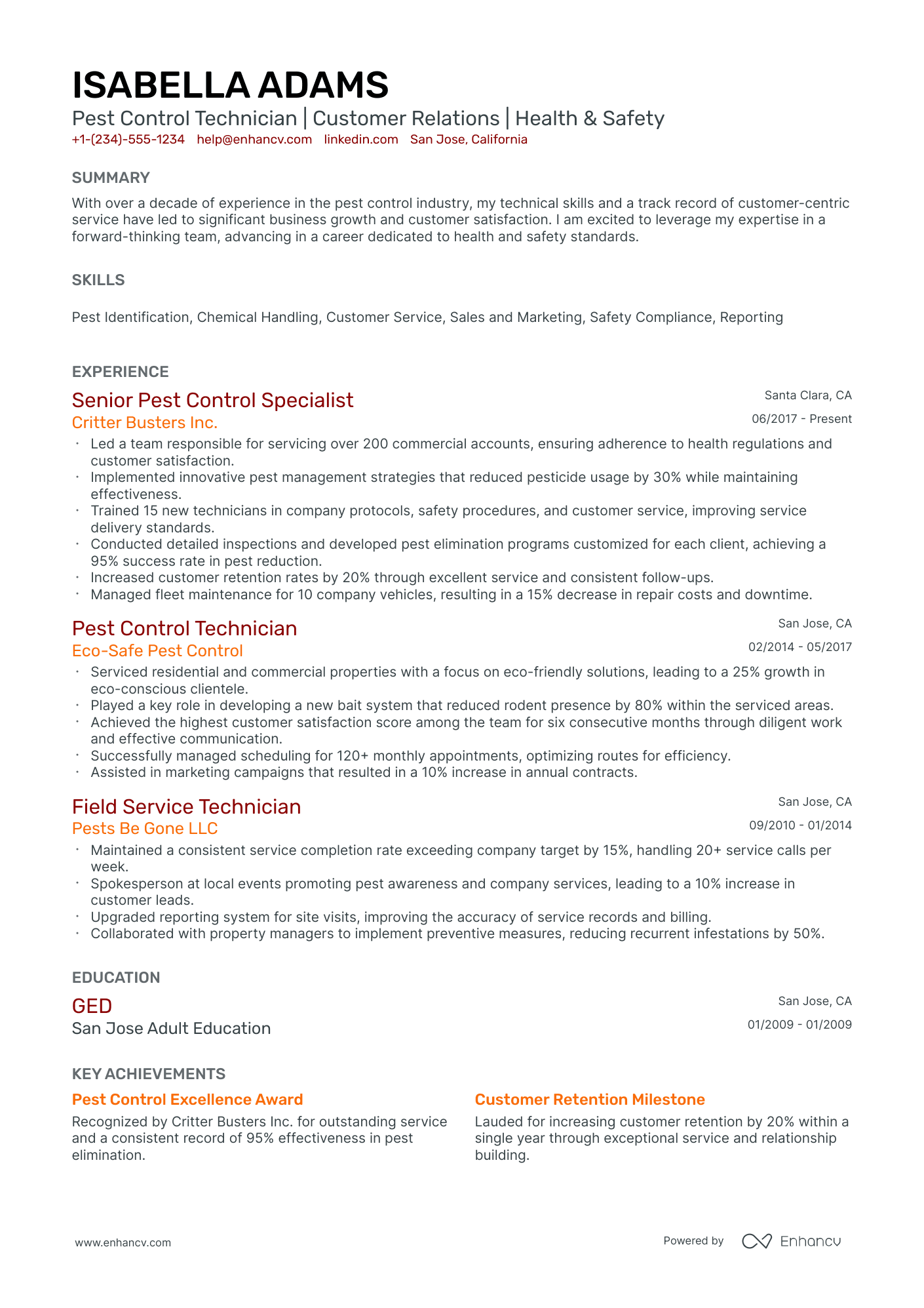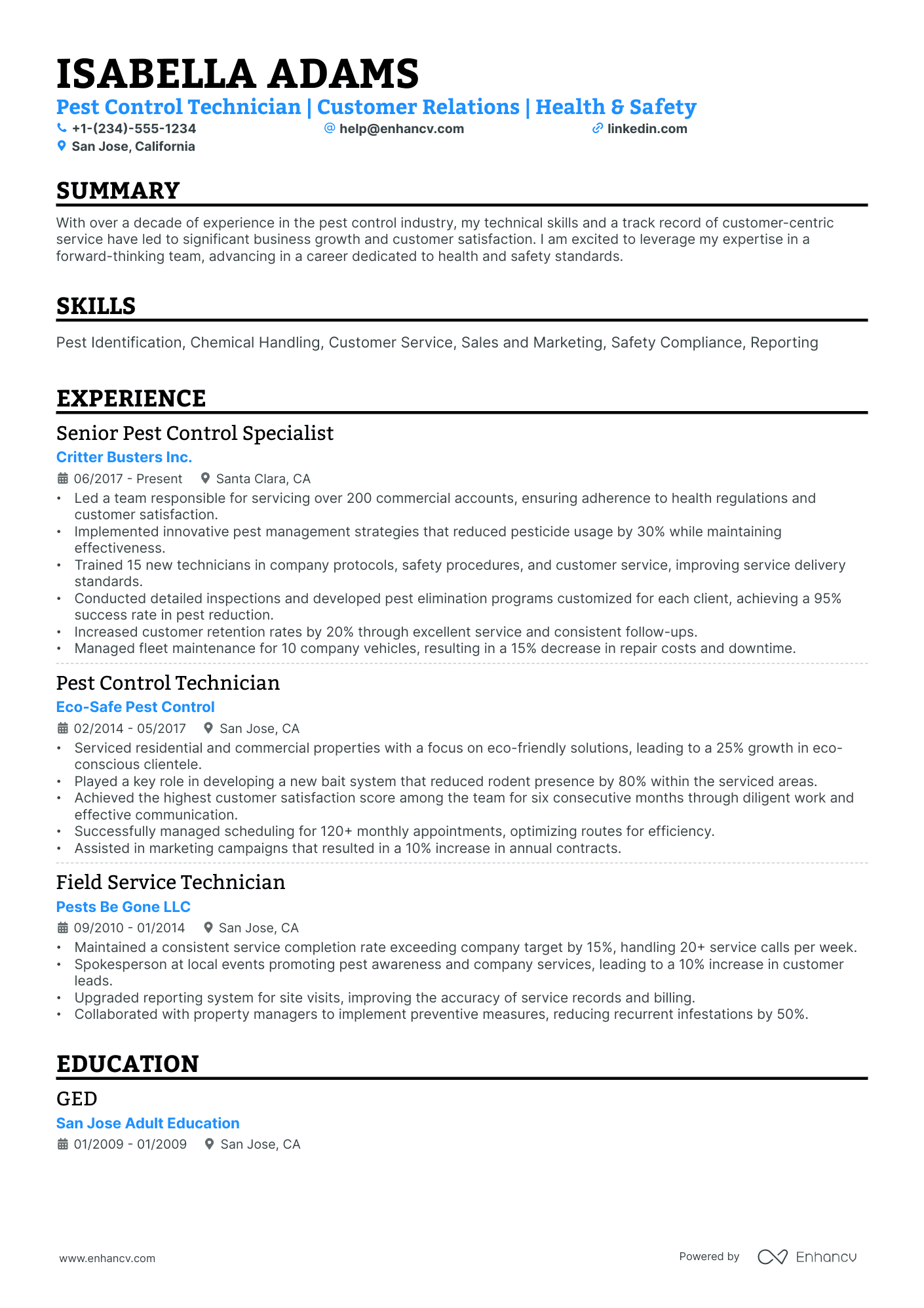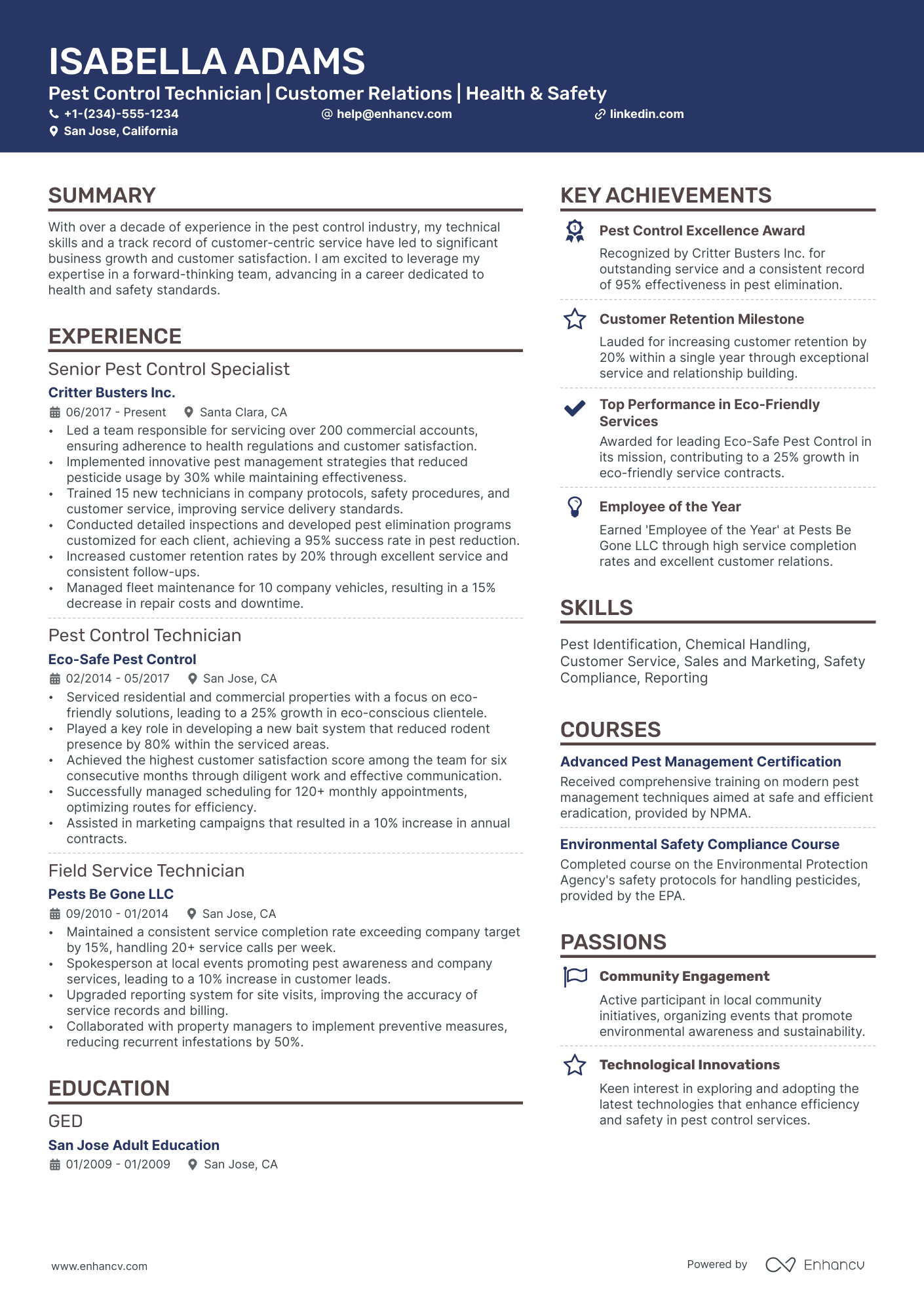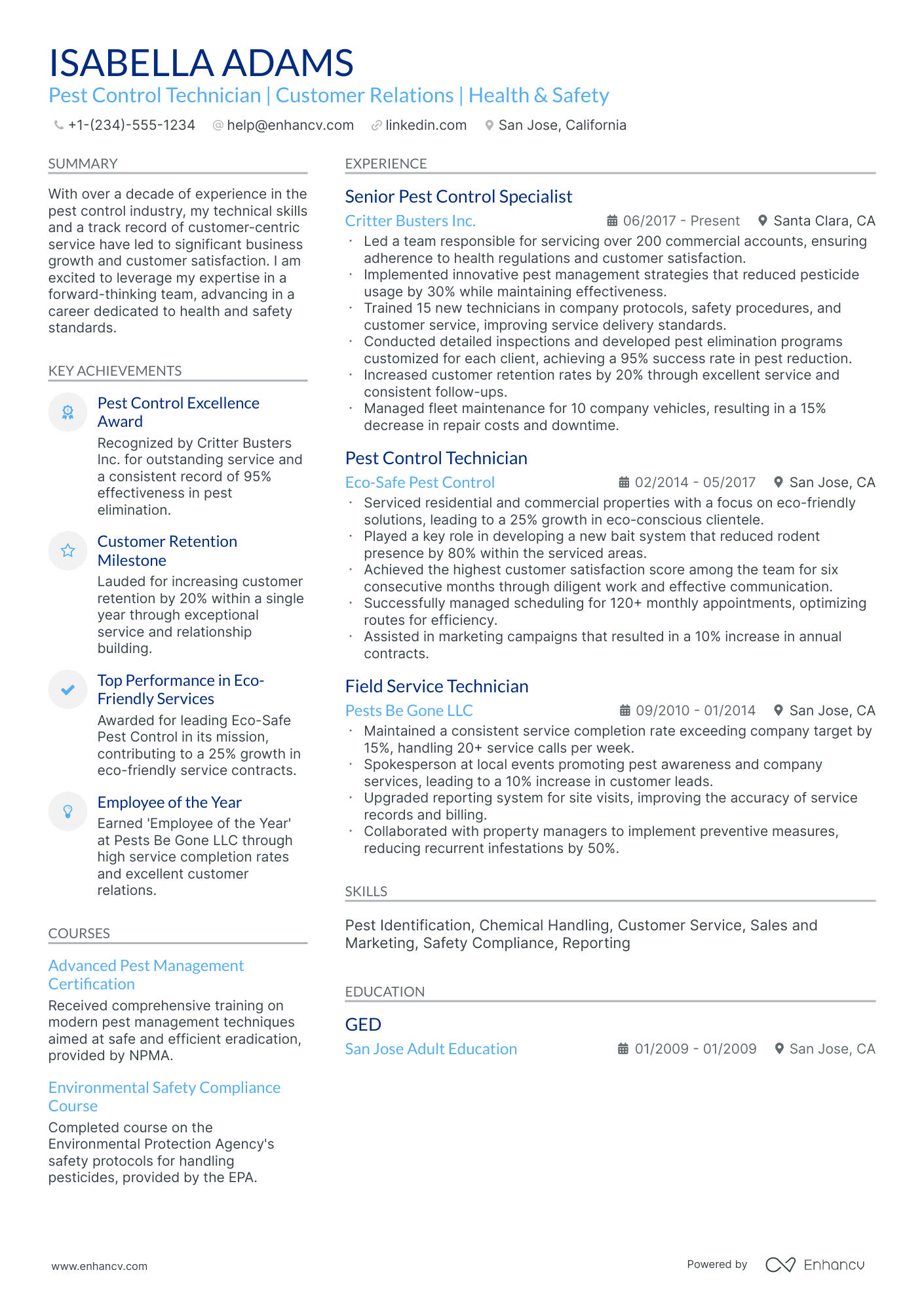As a pest control professional, articulating the diverse skill set required for effectively managing pest infestations and customer interactions can be a resume challenge. Our comprehensive guide offers tailored strategies that help you showcase your expertise and results-driven approach, ensuring your application stands out to potential employers.
- Pest control resume samples that got people hired at top companies.
- How to perfect the look-and-feel of your resume layout.
- How to showcase your achievements and skills through various resume sections.
- How you could hint to recruiters why your resume is the ideal profile for the job.
If the pest control resume isn't the right one for you, take a look at other related guides we have:
- Maintenance Technician Resume Example
- Landscaping Resume Example
- Cleaning Manager Resume Example
- Electronic Technician Resume Example
- Cable Technician Resume Example
- Mechanic Resume Example
- Facilities Manager Resume Example
- Housekeeping Manager Resume Example
- Residential Property Manager Resume Example
- Housekeeper Resume Example
Tips and tricks for your pest control resume format
Before you start writing your resume, you must first consider its look-and-feel - or resume format . Your professional presentation hence should:
- Follow the reverse-chronological resume format , which incroporates the simple logic of listing your latest experience items first. The reverse-chronological format is the perfect choice for candidates who have plenty of relevant (and recent) experience.
- State your intention from the get-go with a clear and concise headline - making it easy for recruiters to allocate your contact details, check out your portfolio, or discover your latest job title.
- Be precise and simple - your resume should be no more than two pages long, representing your experience and skills that are applicable to the pest control job.
- Ensure your layout is intact by submitting it as a PDF. Thus, your resume sections would stay in place, even when assessed by the Applicant Tracker System (ATS).
Upload & Check Your Resume
Drop your resume here or choose a file. PDF & DOCX only. Max 2MB file size.
PRO TIP
Listing your relevant degrees or certificates on your pest control resume is a win-win situation. Not only does it hint at your technical capabilities in the industry, but an array of soft skills, like perseverance, adaptability, and motivation.
Don't forget to include these six sections on your pest control resume:
- Header and summary for your contact details and to highlight your alignment with the pest control job you're applying for
- Experience section to get into specific technologies you're apt at using and personal skills to deliver successful results
- Skills section to further highlight how your profile matches the job requirements
- Education section to provide your academic background
- Achievements to mention any career highlights that may be impressive, or that you might have missed so far in other resume sections
What recruiters want to see on your resume:
- Knowledge of pest identification and behavior
- Experience with pest control techniques and equipment
- Familiarity with safety regulations and the proper use of pesticides
- Strong customer service skills and experience in resolving infestation issues
- Relevant certifications or licenses in pest control or entomology
Experts' advice on writing your pest control resume experience
While the excitement and motivation for writing your pest control resume was present in the first hour (or so), you now find yourself staring at the blank page.
The resume experience section is the one that allows you to make a memorable impression by matching job requirement with your past jobs and accomplishments.
To help you write this resume section, here are four mistakes you need to avoid:
- Listing every job you have had so far, including the irrelevant ones. Before that, consider each of your past roles based on relevancy to the role. It may be the case that the job you had 15 years ago may have taught you invaluable skills that are appropriate for the role;
- Including irrelevant work experience items. Those are past jobs that aren't linked with the role you're applying for (or so they seem). Consider how your past jobs will serve your professional presentation: will they be filling in a gap in your work history, or just taking up space?
- Focusing on responsibilities instead of accomplishments. Your pest control resume shouldn't just be telling recruiters what you did in the past - as it's most often the case that candidates have had similar responsibilities. But, rather, the experience section should showcase the success you've attained in each past role, thanks to your unique skill set;
- Consider listing just your professional experience. Any role you've had in the past - e.g. volunteering, internships, etc. - can make it into your pest control resume experience section. Make sure to include it alongside numbers and results.
Two more things you need to remember about your resume experience section.
The first are keywords. Or those specific job requirements that are crucial for the role . Ensure you've integrated them across your experience section to get sorted closer to the ideal candidate profile by the Applicant Tracker System (ATS).
The second are action verbs. Each of your experience bullets should start with a strong action verb, followed by your specific skill and your on the job achievements. Follow this formula to hint to recruiters what your unique value as a professional is.
Still with us? In the next section, we will show you how industry-leading professionals have avoided the four most common mistakes, while integrating keywords and action verbs in their experience section.
- Led a team of technicians in implementing an Integrated Pest Management program that reduced chemical use by 40% while maintaining pest-free conditions for various clients.
- Designed and executed a customized pest control plan for a 200-acre agricultural site, increasing crop yield by 25% in the first year through effective pest mitigation strategies.
- Initiated and managed a cross-training program for 10 pest control technicians, improving team versatility and response time to client emergencies by 30%.
- Developed a new trapping methodology for rodents, which was adopted company-wide and resulted in a 35% increase in trapping efficiency.
- Conducted regular seminars on pest behavior and control techniques, effectively enhancing client education and reducing call-back rates by 20%.
- Oversaw the successful transition to eco-friendly pesticides across all service offerings, aligning company practices with emerging environmental standards.
- Implemented a data-driven approach to track and predict pest activity, optimizing treatment schedules and leading to a 50% decrease in customer complaints.
- Negotiated and secured 5 major commercial contracts with local businesses, effectively expanding the company's market share by 15%.
- Managed inventory and procurement of pest control supplies, ensuring operational costs were maintained below budget by 10% annually.
- Trained and supervised a rotating staff of 20 technicians, resulting in a 40% improvement in service delivery efficiency.
- Played a pivotal role in piloting a bed bug heat treatment program that became a staple in the company's pest control offerings.
- Expanded services to include wildlife control, diversifying the company's revenue streams and contributing to an 18% annual growth in sales.
- Collaborated with R&D to incorporate biological pest control solutions into existing services, yielding a 25% increase in customer satisfaction due to non-chemical treatment options.
- Directed a large-scale fumigation project for a historic building, which included adhering to strict environmental guidelines and achieving a 100% pest eradication rate.
- Spearheaded a customer loyalty program that boosted retention rates by 20% over a two-year period.
- Established a comprehensive training program for new hires, enhancing the average onboarding process time by reducing it by half.
- Performed detailed pest risk assessments for over 300 residential clients annually, customizing treatment plans to their specific needs while ensuring safety and effectiveness.
- Instrumental in developing a company-wide sustainable pest control initiative, which improved our public image and attracted a 15% increase in ecologically-conscious clients.
- Assisted in the design and launch of a proprietary software for pest activity monitoring, which enhanced real-time decision-making for field technicians.
- Achieved a personal client satisfaction rate of 97% by providing tailored solutions and exceptional follow-up services that addressed all pest concerns.
- Volunteered as the face of the company's community outreach program, educating over 1,500 residents about pest prevention and control and fostering positive community relations.
- Designed an evaluation framework that measured the effectiveness of different pest control strategies, leading to a company-wide adoption and a 20% reduction in the use of less effective treatments.
- Launched a successful marketing campaign focused on humane pest removal services, capturing a niche market segment and increasing total service contracts by 30% within the first year.
- Fostered a partnership with a local sanitation company to co-develop a joint pest and waste management solution, which led to a 25% decrease in rodent-related issues for shared clients.
Quantifying impact on your resume
- Include the number of pest control service calls completed to demonstrate workload handling capability.
- Mention the percentage of repeat customers serviced to showcase customer satisfaction and retention.
- Specify the reduction in infestation incidents post-treatment to highlight effectiveness.
- List the types and amounts of chemicals used to reflect knowledge of industry materials.
- Quantify areas treated (e.g., square footage) to provide a sense of scale and project management.
- Record the number of successful regulatory inspections to indicate compliance with industry standards.
- Document any decrease in operational costs due to improved efficiency or innovative techniques.
- Highlight any training sessions or workshops led, with participant counts, to demonstrate leadership and expertise.
Action verbs for your pest control resume
Lacking relevant pest control resume experience?
Learn how to write your pest control resume experience in spite of having no real-world (or applicable) experience for the job.
You should:
- Feature relevant projects or publications that could impress recruiters or showcase that you have the basic skill set for the job
- Shift the focus towards your people (communication, organization, etc.) skills to demonstrate that you're a quick learner and can easily adapt to a new environment
- Use the resume objective to not only highlight your accomplishments but also map out how your career plans are perfectly aligned with the company's vision
- Select either the functional-skill-based resume format (that puts the focus on your skills) or the hybrid one (balancing expertise with skills).
Recommended reads:
PRO TIP
If the certificate you've obtained is especially vital for the industry or company, include it as part of your name within the resume headline.
In-demand hard skills and soft skills for your pest control resume
A vital element for any pest control resume is the presentation of your skill set.
Recruiters always take the time to assess your:
- Technological proficiency or hard skills - which software and technologies can you use and at what level?
- People/personal or soft skills - how apt are you at communicating your ideas across effectively? Are you resilient to change?
The ideal candidate presents the perfect balance of hard skills and soft skills all through the resume, but more particular within a dedicated skills section.
Building your pest control skills section, you should:
- List up to six skills that answer the requirements and are unique to your expertise.
- Include a soft skill (or two) that defines you as a person and professional - perhaps looking back on feedback you've received from previous managers, etc.
- Create up to two skills sections that are organized based on the types of skills you list (e.g. "technical skills", "soft skills", "pest control skills", etc.).
- If you happen to have technical certifications that are vital to the industry and really impressive, include their names within your skills section.
At times, it really is frustrating to think back on all the skills you possess and discover the best way to communicate them across.
We understand this challenge - that's why we've prepared two lists (of hard skills and soft skills) to help you build your next resume, quicker and more efficiently:
Top skills for your pest control resume:
Pesticide Application
Insect Identification
Rodent Control Techniques
Fumigation Equipment Operation
Integrated Pest Management (IPM)
Chemical Safety and Handling
Trapping and Baiting Systems
Safety Equipment Usage
Environmental Impact Assessment
Regulatory Compliance Knowledge
Communication Skills
Problem-Solving
Attention to Detail
Customer Service Orientation
Time Management
Team Collaboration
Analytical Thinking
Adaptability
Conflict Resolution
Empathy
PRO TIP
If you're in the process of obtaining your certificate or degree, list the expected date you're supposed to graduate or be certified.
Showcase academic background with education and certifications' sections
Listing your education and certifications should be a rudimentary part of your resume writing.
Including your relevant academic background - in the form of your higher education degree and niche-specific certificates - will prove knowledge of the industry.
For your education section:
- Start by including your degree, followed by start and graduation dates, as well as the institution;
- You could include relevant coursework, major/minor , or GPA, only if your've just graduated from college or if this information would further support your application;
- If you have an "ongoing" degree, you can still list it in case you think your diploma can impress recruiters or it's required;
Follow a similar logic for your certifications section by listing the institution, alongside dates you've obtained the certificate. For some of the most recent and relevant industry certificates , check out the next part of our guide:
The top 5 certifications for your pest control resume:
- Certified pest control Technician (CPCT) – National Pest Management Association (NPMA)
- Associated Certified Entomologist (ACE) – Entomological Society of America (ESA)
- QualityPro Certification – National Pest Management Association (NPMA)
- Board Certified Entomologist (BCE) – Entomological Society of America (ESA)
- Structural pest control License (SPCL) – Varies by State (Department of Agriculture or State pest control Regulatory Board)
PRO TIP
Mention specific courses or projects that are pertinent to the job you're applying for.
Recommended reads:
The ideal pest control candidate resume summary or objective
You may have heard that your resume top one-third plays an important part in your application.
It basically needs to show strong alignment with the job advert, your unique skill set, and your expertise.
Both the resume summary and resume objective could be used to ensure you've shown why you're the best candidate for the role.
Use the:
- Resume objective to pinpoint your current successes, that are applicable to the field, and your vision for your career. Remember to state how you see yourself growing within this new career opportunity.
- Resume summary as an instrument to pinpoint what is most applicable and noteworthy form your professional profile. Keep your summary to be no more than five sentences long.
At the end of the day, the resume summary or objective is your golden opportunity to shine a light on your personality as a professional and the unique value of what it's like to work with you.
Get inspired with these pest control resume examples:
Resume summaries for a pest control job
- With over seven years of dedicated experience in pest control and a Master Technician certification, I have effectively managed large-scale infestations and implemented eco-friendly solutions that resulted in a 30% increase in client satisfaction rates in urban and suburban environments.
- Seasoned facilities manager transitioning into pest control, bringing over a decade of expertise in maintaining large commercial properties. Recognized for implementing preventative maintenance strategies that reduced operational costs by 20%, eager to apply this proactive approach to manage pest control solutions.
- Distinguished biologist with extensive knowledge of insect behavior and ecology, seeking to leverage five years of research in entomology into practical pest management solutions that minimize environmental impact and uphold public health standards.
- Eager to transfer skills from five years of experience in landscape architecture, with a keen understanding of plant-pathogen relationships and habitat manipulation strategies, into targeted and sustainable pest control practices that align with natural ecological balances.
- Aiming to embark on a career in pest control, fueled by a passion for environmental science, outstanding problem-solving skills, and a commitment to learning hands-on techniques for managing residential and commercial pest issues with utmost professionalism.
- Dedicated newcomer with a robust background in customer service and sales, looking to pivot into the pest control industry. Driven to acquire technical expertise through rigorous training and express a strong desire to master environmentally responsible pest management practices that benefit communities.
Miscellaneous pest control resume sections for a more personalized approach
Your pest control resume can reflect even more upon your personality and best qualities - that is if you decide on including a couple of additional resume sections to support your application.
Some of the best-accepted industry-wide choices include the:
- Resume projects - getting into the outcomes of your most important work, so far;
- Languages on your resume - detailing your proficiency level;
- Special recognitions - dedicated to your most prominent industry awards;
- Hobbies and interests - defining how you spend your free time.
Key takeaways
At the end of our guide, we'd like to remind you to:
- Invest in a simple, modern resume design that is ATS friendly and keeps your experience organized and legible;
- Avoid just listing your responsibilities in your experience section, but rather focus on quantifiable achievements;
- Always select resume sections that are relevant to the role and can answer job requirements. Sometimes your volunteering experience could bring more value than irrelevant work experience;
- Balance your technical background with your personality traits across various sections of your resume to hint at how much time employers would have to invest in training you and if your profile would be a good cultural fit to the organization;
- Include your academic background (in the form of your relevant higher education degrees and certifications) to show recruiters that you have the technical basics of the industry covered.
